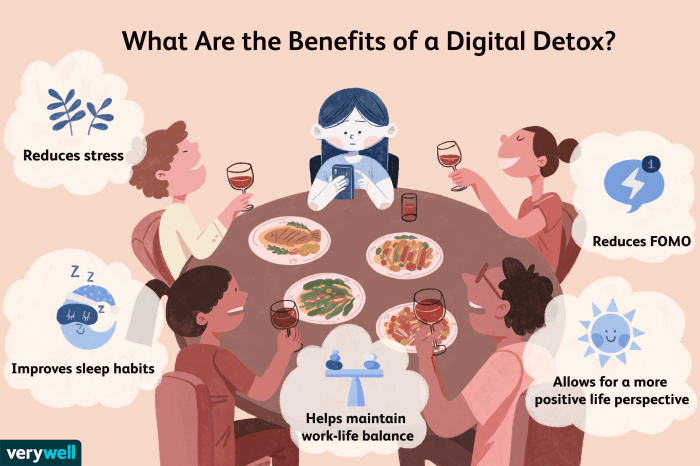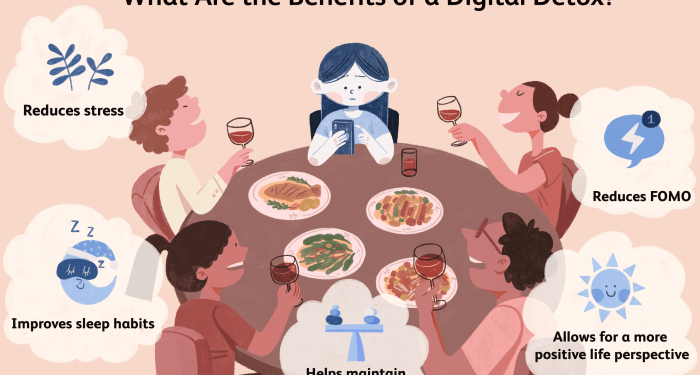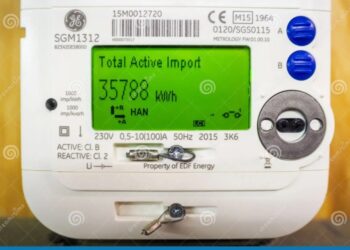Embark on a journey into the world of digital detox with a focus on why your digital life could benefit from a much-needed break. Explore the impact of excessive screen time on mental health, the signs indicating the need for a detox, and strategies for a successful detox to achieve a healthier balance between online and offline activities.
Introduction to Digital Detox
A digital detox refers to a period of time during which a person refrains from using electronic devices such as smartphones, computers, and tablets. It is essential in today's fast-paced digital world to take a break from constant screen time to maintain mental well-being and overall health.
Impact of Excessive Screen Time on Mental Health
Studies have shown that excessive screen time can lead to various mental health issues such as anxiety, depression, and sleep disturbances. The constant exposure to digital devices can also negatively impact cognitive function and social interactions.
Benefits of Taking a Break from Digital Devices
- Improved sleep quality: Limiting screen time before bed can help regulate sleep patterns and improve overall sleep quality.
- Enhanced focus and productivity: By reducing distractions from digital devices, individuals can concentrate better on tasks and be more productive.
- Better mental health: Disconnecting from screens can reduce stress levels and improve overall mental well-being.
Examples of How Digital Detox Can Improve Overall Well-being
- Increased mindfulness: Taking a break from screens allows individuals to be more present in the moment and practice mindfulness.
- Enhanced relationships: Spending quality time away from screens can strengthen relationships with family and friends.
- Physical activity: Without the constant use of digital devices, individuals are more likely to engage in physical activities and outdoor pursuits.
Signs You Need a Digital Detox
In today's digital age, it's easy to become consumed by our smartphones, social media, and constant connectivity. However, there are signs that indicate when it might be time to take a step back and detox from your digital life.Constant connectivity can have a negative impact on our productivity and ability to focus.
The constant notifications, alerts, and distractions from our devices can make it difficult to concentrate on tasks at hand, leading to decreased efficiency and overall performance.
Feeling of Overwhelm
- Constantly checking your phone or social media accounts, even when it's not necessary.
- Feeling anxious or stressed when you're unable to access your devices.
- Struggling to disconnect and relax without technology nearby.
Decreased Productivity
- Finding it challenging to complete tasks without getting sidetracked by notifications.
- Taking longer to finish work due to frequent interruptions from digital devices.
- Feeling like you're always busy but not accomplishing much at the end of the day.
Improved Well-being After Detox
“After taking a digital detox, I found myself more present in the moment and able to enjoy my surroundings without constant distractions.”
Sarah
“I noticed a significant improvement in my mental health and sleep quality after reducing my screen time and focusing on real-life interactions.”
John
Recognizing the Need to Unplug
- Pay attention to how often you reach for your phone out of habit, rather than necessity.
- Take note of how technology makes you feel - if it causes stress or affects your mood negatively, it might be time for a detox.
- Listen to feedback from friends and family who notice changes in your behavior or well-being due to excessive screen time.
Strategies for a Successful Digital Detox
In a world dominated by technology, it can be challenging to disconnect and take a break from screens
Gradually Reduce Screen Time
One effective way to start your digital detox journey is by gradually reducing your screen time. Begin by setting small goals, such as turning off your devices an hour before bed or limiting social media use to a specific time frame each day.
Slowly decrease your screen time until you reach a healthy balance.
Set Boundaries with Technology Use
Establishing boundaries with technology is essential for a successful digital detox. This can include creating tech-free zones in your home, setting specific times for checking emails or notifications, and avoiding screens during meals or family time. By setting clear boundaries, you can regain control over your tech usage.
Create a Healthy Balance Between Online and Offline Activities
Finding a healthy balance between online and offline activities is key to a successful digital detox. Replace screen time with activities that bring you joy and relaxation, such as reading a book, going for a walk, practicing mindfulness, or engaging in a hobby.
Strive to create a well-rounded lifestyle that includes both digital and non-digital experiences.
Engage in Offline Activities During the Digital Detox
During your digital detox, it's important to engage in offline activities that nourish your mind, body, and soul. Consider spending time in nature, socializing with loved ones face-to-face, exercising, cooking a meal from scratch, or practicing gratitude. These activities can help you reconnect with yourself and the world around you, fostering a sense of well-being and fulfillment.
Impact of Digital Detox on Relationships
Excessive screen time can have a detrimental effect on our relationships with family and friends. Constantly being glued to our devices can lead to misunderstandings, lack of communication, and a sense of disconnection in our personal connections. It can hinder our ability to truly connect with our loved ones and be present in the moment.
Benefits of Disconnecting for Improved Communication
- Enhanced quality time: By reducing screen time, we can focus on spending quality time with our loved ones without distractions.
- Improved communication: Disconnecting allows us to have meaningful conversations and truly listen to our family and friends.
- Strengthened bonds: Digital detox can help strengthen bonds with loved ones by fostering deeper connections and understanding.
Tips for Maintaining Healthy Relationships
- Set boundaries: Establish boundaries for device usage when spending time with family and friends to prioritize face-to-face interactions.
- Engage in activities together: Plan activities that involve physical interaction and bonding to create lasting memories.
- Practice active listening: Be present in conversations and show genuine interest in what your loved ones have to say.
Examples of Strengthening Bonds with Loved Ones
By disconnecting from our devices and engaging in meaningful activities together, we can create lasting memories and deepen our relationships with family and friends.
Final Wrap-Up

In conclusion, taking a step back from the digital realm can lead to improved well-being, stronger relationships, and enhanced overall quality of life. By recognizing the signs, implementing effective strategies, and engaging in meaningful offline activities, you can pave the way for a healthier and more fulfilling digilife.
Questions and Answers
Can a digital detox really improve mental health?
Yes, disconnecting from digital devices can have a positive impact on mental health by reducing screen time-related stress and improving overall well-being.
How can I tell if I need a digital detox?
Common signs include feeling constantly distracted, experiencing eye strain, and noticing a decrease in productivity due to excessive screen time.
What are some practical steps to reduce screen time?
Setting specific time limits for device usage, engaging in offline hobbies, and creating technology-free zones are effective ways to gradually reduce screen time.
How can a digital detox impact relationships?
Disconnecting from digital devices can strengthen bonds with loved ones by improving communication, fostering quality time together, and reducing distractions.














